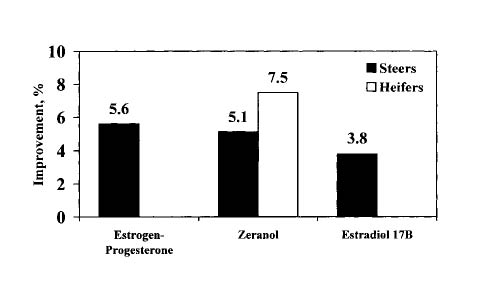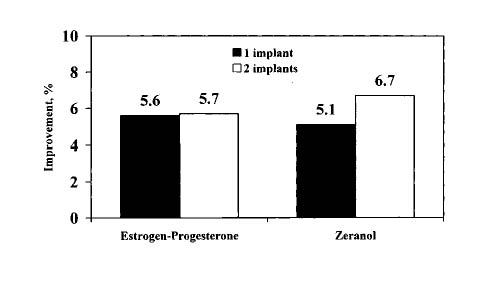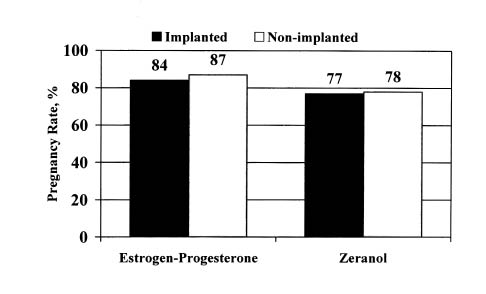Use of Growth Implants in Suckling Beef Calves
Guide B-218
Clay P. Mathis
College of Agricultural, Consumer and Environmental Sciences, New Mexico State University
Author: Extension Livestock Specialist, Department of Extension Animal Sciences and Natural Resources, New Mexico State University. (Print Friendly PDF)
Summary
Implanting growth promotants in suckling steer and heifer calves at branding can significantly enhance average daily gain between branding and weaning, improving the profitability of a ranching operation. However, it is important to use only products labeled for use in suckling beef calves. Special consideration must also be given to implant strategies for replacement heifers. However, reduced reproductive performance in replacement heifers implanted only once between 1 and 3 months of age is minor and is generally offset by improved weaning weights among heifers marketed at weaning.
Introduction
New products and technologies are continually introduced to cow-calf producers. In general, most products or new technologies require an increase in input with the expectation of an improvement in animal performance that will return an increase in cash flow above the cost of implementing the new technology. Growth implants were first approved for beef cattle in the 1950s (Raun and Preston, 1997). Since that time, a great deal of research has created growth-promoting products that are easy to use and that yield consistent responses. To be effective, implants must be properly deposited in the mid-ear site between the skin and ear cartilage according to the manufacturer's recommendations.
Although growth implants have been demonstrated to be effective and profitable technologies, adoption has been limited. A review by Selk (1997) concludes that the use of growth-promoting implants in suckling beef calves increases average daily gain (ADG) by 0.1 lb/day in steers and by 0.12 to 0.14 lb/day in heifers from implanting to weaning.
Nevertheless, 1997 data from the National Animal Health Monitoring System indicate that only 14.3 percent of all cow-calf operations nationwide implant suckling calves. However, among operations with more than 300 cows, 55.4 percent implant suckling calves. Even so, this represents a huge loss of opportunity for increased returns among producers who do not implant suckling calves.
The objective of this guide is to highlight research findings concerning the use of growth-promoting implants in suckling beef calves, and to provide general recommendations regarding the use of these products in suckling steers and heifers intended for sale, as well as replacement heifers intended for breeding.
What Implants Are Available for Suckling Calves?
Currently, there are three types of growth implants available for use in suckling calves (Tables 1 and 2). They are
- 10 mg estradiol benzoate plus 100 mg progesterone (Component E-C, Synovex C),
- 36 mg zeranol (Ralgro), and
- 25.7 mg estradiol (Compudose) or 43.9 mg estradiol (Encore).
| Table 1. Reference Chart and Guidelines for Implants Approved for Use in Suckling Steers, Heifers, and Replacement Heifers* | |||
|---|---|---|---|
| Ingredient/Dosage | Implant | Age requirement | Company |
| 10 mg estradiol benzoate and | Component E-C | Greater than 45 days | Elanco |
| 100 mg progesterone | Synovex C | Greater than 45 days | Fort Dodge Animal Health |
| 36 mg zeranol | Ralgro | Greater than 30 days | Intervet/Schering-Plough Animal Health |
| *Products should not be administered to bulls intended for breeding. | |||
All of the above products can be used in steers and heifers that are not intended for reproduction. However, only Calf-oid, Component E-C, Synovex C, and Ralgro are labeled for use in replacement heifers. Never implant replacement bulls with any growth promotant.
| Table 2. Approved for Use in Suckling Steers, But Not in Suckling Heifers or Bull Calves Intended for Breeding* | |||
|---|---|---|---|
| Ingredient/Dosage | Implant | Age requirement | Company |
| 25.7 mg estradiol | Compudose | Greater than 45 days | Elanco |
| 43.9 mg estradiol | Encore | Greater than 45 days | Elanco |
| *Products should not be administered to bulls intended for breeding. | |||
Influence of Growth Promotants on ADG in Suckling Calves
A thorough review of research pertaining to the effects of growth-promoting implants on preweaning ADG of suckling steers and on both growth and reproductive performance of suckling heifers was presented at an Oklahoma State University-sponsored beef symposium (Selk, 1997).
Selk's review indicates that, regardless of approved implant type, there is a marked increase in ADG in suckling steers that received one implant compared with non-implanted steers (Figure 1). The average improvements in ADG attributed to a single implant containing estrogen-progesterone (13 trials; Calf-oid, Component E-C, Synovex C), zeranol (23 trials; Ralgro), or estradiol (14 trials; Compudose) were 5.6, 5.1, and 3.8%, respectively.
Selk (1997) also summarized the results of eight trials comparing the ADG of heifers implanted once with zeranol to non-implanted heifers. The average improvement in ADG attributed to the growth implants was 7.5% greater than non-implanted controls.
However, it should be noted that variation among environmental conditions and growth potential of calves used in these trials might be high. Therefore, relative differences in preweaning ADG response among the three product types is not necessarily a valid comparison. According to Selk (1997), deciding whether or not to implant suckling calves is more important than deciding which implant to use.
In general, the payout period is from 60 to 120 days (Mader, 1997) for Component E-C, Synovex C, and Ralgro. Component E-C and Synovex C can be administered as early as 45 days of age, and Ralgro at 30 days of age. If calves are implanted at branding and the payout is 60 to 120 days, the implant will be of little value after the calf is 5 to 6 months old.
Yet there still are one to three months until weaning. Should you re-implant these calves? Re-implanting before weaning may yield some additional gain, but it is not likely to be cost-effective if the calves will be sold at weaning. Figure 2 illustrates that the average improvement in preweaning ADG attributed to two implants (estrogen-progesterone, 6 trials; zeranol, 14 trials) exceeded the average improvement attributed to one implant by only 0.1 and 1.6 percentage units for implants containing estrogen-progesterone or zeranol, respectively.
Regardless of the type of implant, the environmental conditions and the potential growth rate of calves can have a great effect on the magnitude of response to growth-promoting implants. More specifically, as compared with non-implanted calves in the same environment, a group of higher-performing calves in a good environment for growth generally will show a greater performance improvement in response to growth promotants than will lower-performing calves in a poor environment for growth.

Figure 1. Average improvement in average daily gain of suckling steers and heifers implanted once with either estrogen-progesterone (Calf-oid, Component E-C, Synovex C; 13 trials), zeranol (Ralgro; steers = 23 trials, heifers = 8 trials), or estradiol 17 (Compudose; 14 trials) versus non-implanted controls (adapted from Selk [1997]).

Figure 2. Average improvement in average daily gain of suckling steers implanted once or twice with estrogen-progesterone (Calf-oid, Component E-C, Synovex C; 2 implants = 6 trials) or zeranol (Ralgro; 2 implants = 14 trials) versus non-implanted controls (adapted from Selk [1997]).

Figure 3. Average pregnancy rate among heifers implanted once between 1 and 3 months of age with estrogen-progesterone (Calf-oid, Component E-C, Synovex C; 9 trials) or zeranol (Ralgro; 13 trials) versus non-implanted controls (adapted from Selk [1997]).
Influence of Growth Promotants on Reproductive Performance in Replacement Heifers
Some research evaluating the use of growth promotants in suckling replacement heifers has generated concern regarding the future reproductive performance of implanted replacement females. These findings create a dilemma because it is not always possible to determine at branding which females will become replacements, so in many cases none of the suckling heifers are implanted. This results in a lost opportunity to improve ADG in heifers that will be marketed at weaning.
However, Selk's review (1997) of trials evaluating the influence of implanting suckling heifers once between 1 and 3 months of age with estrogen-progesterone (9 trials) or zeranol (13 trials) indicates that pregnancy is only slightly lower for implanted replacement heifers than non-implanted heifers (Figure 3). However, Selk's (1997) summary of 10 trials showed that pregnancy rate of heifers implanted twice with zeranol was reduced by 7.3 percentage units compared with non-implanted controls. A decline of this magnitude may have a substantial impact on the overall performance of a beef herd.
Therefore, implanting all heifers at 1 to 3 months of age typically improves weaning weights on all heifers, yet the negative effects of implanting on reproductive performance will be minimal or nonexistent. However, never implant replacement heifers before 1 month or after 3 months of age.
Economics of Implanting Suckling Calves
Deciding to implant suckling calves with growth-promoting implants almost always makes good economic sense, as long as products are used according to their labels.
For example, we can assume that the additional cost of implanting calves at branding is about $1 per calf (the increase in labor is minimal). The average weight and sale price of all steer and bull calves sold from New Mexico ranches participating in the Standardized Performance Analysis (SPA) program between 1991 and 1999 were 560 pounds and $79/cwt.
For the purpose of this example, let's consider a group of non-implanted calves that weigh 550 pounds apiece at weaning. If these steer calves were implanted at branding and gained an additional 0.1 pound/head/day from branding (60 days of age) to weaning (210 days of age), they would weigh 15 pounds more per head at weaning (210 days - 60 days = 150 days x 0.1 pound/day increase in ADG = 15 pounds). Therefore, the average weaning weight would be 565 pounds per calf.
If these implanted calves sold for $78/cwt and would have sold for $79/cwt if they were 15 pounds lighter (non-implanted), then the implanted calves would have returned $440.70/head versus only $434.50/head if they were not implanted. Implanting would have been worth $6.20 per head, less approximately $1 for the cost of the implant-a net gain of $5.20/head.
To carry this example a step further, let's assume that all steer and heifer calves are marketed at weaning and that the enhancement in performance response to growth implants in the heifers is equal to that of the steers. Therefore, we can calculate a net profit of $5 per cow ($5.20/weaned calf x 96.2% [average calf survival from birth to weaning from SPA data]). Average net income for New Mexico ranches participating in the SPA program from 1991 to 1999 was $6.09 per cow. Adding $5 to $6.09 yields a net profit of $11.09 - an 82% increase in net income per cow. Clearly, implanting makes good economic sense in this example.
Recommendations
- Follow label instructions on all growth-promoting products.
- Implant all suckling steer and heifer calves at branding.
- If replacement heifers can be identified at branding, do not implant them.
- Never use growth promotants on bull calves intended for reproduction.
- Do not re-implant calves intended for sale at weaning.
References
Mader, T.L. 1997. Carryover and lifetime effects of growth promoting implants. In Symposium: Impact of implants on performance and carcass value of beef cattle (pp. 88-94). Stillwater: Oklahoma Agricultural Experiment Station.
National Animal Health Monitoring System. 1997. Part II: Reference of 1997 beef cow-calf health and health management practices. Washington, D.C.: U.S. Department of Agriculture.
Raun, A.P., and R.L. Preston. 1997. History of hormonal modifier use. In Symposium: Impact of implants on performance and carcass value of beef cattle (pp. 1-9). Stillwater: Oklahoma Agricultural Experiment Station.
Selk, G. 1997. Implants for suckling steer and heifer calves and potential replacement heifers. In Symposium: Impact of implants on performance and carcass value of beef cattle (pp. 40-50). Stillwater: Oklahoma Agricultural Experiment Station.
Brand names appearing in publications are for product identification purposes only. No endorsement is intended, nor is criticism implied of similar products not mentioned. Persons using such products assume responsibility for their use in accordance with current label directions of the manufacturer.
To find more resources for your business, home, or family, visit the College of Agricultural, Consumer and Environmental Sciences on the World Wide Web at pubs.nmsu.edu
Contents of publications may be freely reproduced for educational purposes. All other rights reserved. For permission to use publications for other purposes, contact pubs@nmsu.edu or the authors listed on the publication.
New Mexico State University is an equal opportunity/affirmative action employer and educator. NMSU and the U.S. Department of Agriculture cooperating.
Revised and electronically distributed July 2010 Las Cruces, NM.


